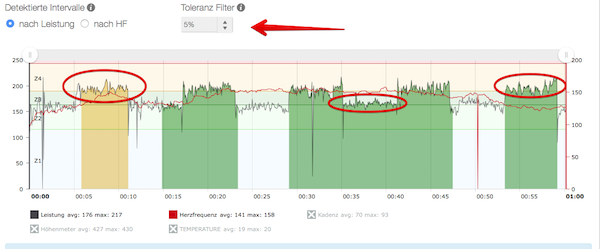What is actually the difference between interval training and a multiple steady sessions at comparable intensities?
Unstructured Mixed Training
When we train freely according to our mood, we behave differently than with a structured interval training and also achieve a different load, which usually means a weaker training stimulus. The data can be deceiving here. Without any particular motivation and structured timed intervals, you unconsciously build in recovery phases before going as hard as you should. This happens just when the intensity (and the training stimulus) increases. That is why in unstructured training there is always a maximum effort. Such a training can be quite fast in total, but it does not provide an optimal training stimulus and it does not show the true strength of an athlete.
Interval Training

In interval training the specific stimulus and intensity is well-defined and easier to achieve. The body should continue to perform despite being fatigued because you know you have to do X number of minutes hard before a rest. The motivation to perform at your top levels usually arises mainly in racing situations, but can also be generated by a given interval structure. it is almost impossible to achieve this in an unstructured training session.
It is helpful if the quality of an interval can be measured directly and objectively for the athlete. Power meters are a great tool for cyclists here, because you always have the targeted performance level in view and can act accordingly. Runners can effectively control their intervals by looking at time and distance, especially on the track.
If you are unable to hit normal power or paces during interval training, this is likely an indication that you are not properly recovered and the session should be modified or moved to another day. In this case instead of staying below the desired stimulus and doing a moderate effort, it is better to train only lightly and to postpone the interval training (2PEAK will automatically schedule a higher load due to the “unexpected recovery”). When interval power drops more than 5% during repetitions, this indicates the training should be postponed.
Learning to Push Limits
Competitive athletes who test the limits learn that the body can withstand more than “non-athletes” can even imagine. They exhaust the reserves a little more and thus set stronger stimuli, which result in stronger and faster adjustments. As a consequence, interval training is a method of shifting performance limits faster than is possible with constant stress. The goal of fulfilling an interval also increases mental strength. The brain learns to accept a higher performance and only later throttles the muscle performance.
Another positive aspect of interval training is that if you train really hard from time to time, you do less moderate training overall and appreciate calmer workouts more. This is helpful, because when basic training is required – for example to optimize fat burning – it is definitely helpful not to constantly move into different speed ranges activating different metabolic states. As such, interval training indirectly benefits the quality of basic training as well.
Conclusion
Autonomously chosen training is often mixed and moderate training. This form of training can be recognized by the fact that there are different intensities, but it is never intense enough to push your limits. The feel-good area is rarely left in unstructured training. It is better to break the training down into its basic components and to train them in a structured way. This training strategy provides greater stimuli and brings faster training success. This is exactly what interval training does.